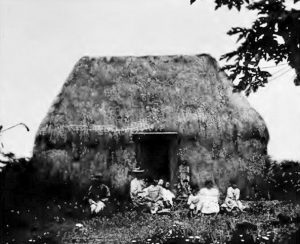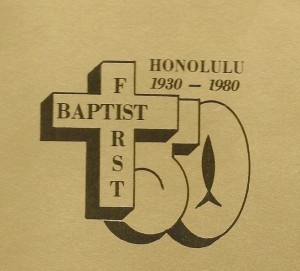 Our Golden Jubilee 1930-1980
Our Golden Jubilee 1930-1980
http://catherinecrouch.com/wp-content/ALFA_DATA “And you shall hallow the fiftieth year, and proclaim liberty throughout the land to all its inhabitants; it shall be a jubilee for you…it shall be holy to you.” Leviticus 25:10-12
CHRISTIAN BEGINNINGS IN HAWAII
On the occasion of the jubilee anniversary of the First Baptist Church of Honolulu we celebrate our small part of God’s greater work and witness in these Hawaiian Islands. We shall avoid the temptation of attempting, too closely to pinpoint the beginning of God’s active concern for the people of Hawaii but certainly any rendering of such would include some of these components:
- The broadly published report of the voyages of Captain Cook quickened the concern of evangelical Christians for the people of the Pacific islands.
-
In 1820 the brig Thaddeus off-loaded the first company of “Boston missionaries” and Hiram Bingham chose as his text for his first service in Honolulu, Fear not, for behold, I bring you good tidings of great joy, which shall be for all people.
- Just a few years later, on the Big Island, Congregational missionary Lorenzo Lyons baptized 1,700 new believers in a single day.
- In 1842 the young Hawaiian seaman, “Henry” Opukaka`ia, entered Yale, and then the Foreign Mission School at Cornwall, Connecticut, sowing the seeds of missionary zeal among his classmates? Ol Kalou FOR MORE INFORMATION ABOUT HAWAII MISSIONS AND MISSIONARIES CLICK HERE
- In 1852, Hawaiian churches organized their own Missionary Society to send evangelists southwestward into Micronesia
All of these events tell a part of the story; none of them tell it all. All of these strands weave part of the fabric, but the real beginning of the tapestry, we believe, is described in the first chapter of Genesis where it says the Spirit of God was moving over the face of the waters. That same Spirit may well have been the force a thousand years ago guiding and greeting the voyagers whose double-hulled canoes first scraped the beaches of this, “the loveliest fleet of islands anchored in any ocean.” On February 12, 1930, another part of the story begins to unfold when the First Baptist Church of Honolulu was officially birthed into life in the auditorium of Kuhio School
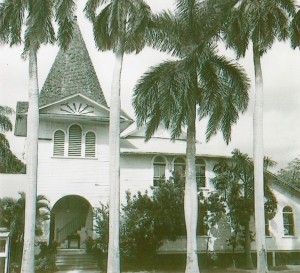 THE WITNESS ON CORNER OF KINAU AND PENSACOLA (1905-1932)
THE WITNESS ON CORNER OF KINAU AND PENSACOLA (1905-1932)
Our history is uniquely tied to the Makiki Christian Church. Seventy-five years before this corner became our home it was their home. In the summer of 1905, under the leadership of Pastor Takie Okumura, the infant Makiki Christian Church purchased 10,000 square feet of land for $2,100 and erected a substantial building seating 400 persons, mostly of Japanese ancestry. During the previous four decades, more than 100,000 Japanese immigrants had come to Hawaii, and the Hawaiian Evangelical Association of the Congregational Churches had worked diligently to minister effectively to the newcomers. The Rev. Takie Okumura had been called to Hawaii immediately after graduation from seminary in Japan, and had served the Nuuanu Congregational Church for seven years before beginning the Makiki work in 1904. In 1979, Makiki Christian Church celebrated its 75th anniversary with many remembrances of the quarter century on “our corner.”
As a part of its 25th anniversary celebration in 1929, Makiki Christian laid plans to purchase a much larger lot a few blocks seaward, and Pastor Okumura fulfilled his dream of building – to the glory of God – a church building in the architectural tradition of a Japanese castle. The “castle-church” was dedicated on November 6, 1932. The members of First Baptist Church of Honolulu are grateful “for all the saints who from their labors rest,” and particularly for those who first planted the seeds of the Gospel on the corner of Kinau and Pensacola. Each member of First Baptist should find opportunity to visit Makiki Christian, its “older sister church, to study the richness of the symbolism of the building and to experience the commitment and aloha of those who worship within and witness without.
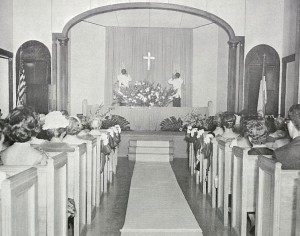 A BAPTIST CHURCH BEGUN (1930-1932)
A BAPTIST CHURCH BEGUN (1930-1932)
Until 1927, most of the Baptists transplanted to Honolulu worshipped with the Disciples of Christ (who organized in 1894) or with one of the many Congregational churches. In those days, the major denominations honored the International Comity Agreements which sought to minimize evangelistic competition within areas of the world already churched. Hawaii was considered Congregational territory. Thus, in 1927, when a few Baptists began meeting for Bible study, prayer, and fellowship, they received no encouragement from denominational headquarters, and some official opposition from among the established churches of Honolulu. The embryonic church expired within a year, but the movement resurfaced in 1929 as Baptist believers continued to seek a free and satisfying expression of their faith. They called an organizational meeting on February 12, 1930, at the auditorium of Kuhio School.
Records of the meeting, including the names of those present, have been lost, but the Charter filed with the Territorial Government pinpoints the date of February 12, 1930, as the official beginning of the “First Baptist Church and Bible College of Honolulu, T.H.” Unfortunately, there was little demonstration of unity in this new Baptist body of believers, and after two years of regular meetings at the Ka`ahumanu Elementary School the congregation had gained little more than a reputation as “a group of fighters.” If the church was to survive, strong and positive leadership was needed. Through God’s grace, that need was met, if only briefly, in the summer of ’32, with the arrival of Dr. John M. Dean.
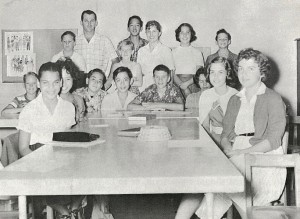 THE CHURCH ESTABLISHED AND CONNECTED (1932-1945)
THE CHURCH ESTABLISHED AND CONNECTED (1932-1945)
A member of the Albany Park Baptist Church of Chicago had visited Honolulu in 1931, and had returned to tell the story of the leaderless little flock. As a result, Dr. and Mrs. John M. Dean were granted a leave from Albany Park to spend a few months assisting the Honolulu congregation. Between April and September 1932, Dean’s experienced leadership as first pastor brought the sense of direction and enthusiasm which had been needed. Under his leadership the name was changed to Calvary Baptist Church “in order to avoid the poor reputation already developed in Honolulu.” Jacob C. Ziegler was elected lay leader. He had been with the congregation from the beginning and would continue to be a main-stay for years to come.
The first baptismal service was held at Waikiki Beach on June 12, 1932, and a new member by transfer, Charles J. McDonald, a man of considerable Baptist background, was licensed to preach. (Soon McDonald would serve as the second pastor and, a few years later, would become one of the leaders in the establishment of Southern Baptist ministry in the islands.) Discussions were held with the Makiki Christian Church regarding the soon-to-be-vacant building at Pensacola and Kinau. An agreement was reached to rent it for thirty dollars a month, an arrangement that would continue until 1938, when the property was purchased for $5,700.
Another legacy of Pastor Dean’s short ministry here was the strong recommendation to establish a connection with a mainland Baptist denomination. Dean initiated correspondence with Southern Baptists, but nothing came of the overtures. In 1934, Calvary Baptist was contacted by the General Association of Regular Baptists (GARB), and the Rev. Edward M. Shipman, an able minister of that background, served the church from 1934 to 1945, the longest tenure of any pastor to date. Despite Shipman’s own ties with the GARB, no organizational connection developed. Finally, discussions were held with the American (then called Northern) Baptists of Southern California, which came to fruition shortly before Pearl Harbor.
Pastors and Dates of Service
 Dr. John M. Dean, June 1, 1932 – Sept. 8, 1932
Dr. John M. Dean, June 1, 1932 – Sept. 8, 1932- Charles J. McDonald, Sept. 8, 1932 – Sept. 1, 1934
- Rev. A. E. Adams, Oct. 2, 1932 – June 1, 1935
- Rev. Edward M. Shipman*, Aug. 7, 1934 – Oct. 1, 1945
- Dr. Harold A. DeGraff**, Oct. 24, 1945 – May 30, 1946
- Rev. Harden V. Rowland, Mar. 27, 1946 – May 28, 1947
- Dr. Harold A. DeGraff, June 1, 1946 – May 26, 1948
- Rev. Louis Barrett, Oct. 1, 1948 – June 30, 1954. Rev. H. A. Gibbons (Assistant)
- Rev. Robert Bradford, Feb. 1955 – Dec. 31, 1958. Rev. Steven Wong (Assistant)
- Rev. James Ledbetter, Sept. 1, 1959 – Dec. 31, 1964
- Rev. John D. Knighton, June 1, 1965 – Aug. 31, 1969
- Dr. William Tipton, Mar. 7, 1970 – _____. Rev. Glenn Connell (Associate)
*Shipman served from 1934-35 as Assistant and Acting Pastor, then from Oct. 7, 1935 as pastor. **DeGraff served first as Acting Pastor, then as Missionary Pastor under Rowland.
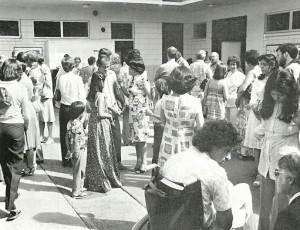 A Time of Lights and Shadows (1945-1954)
A Time of Lights and Shadows (1945-1954)
Calvary Baptist Church weathered World War II pretty well. Under the steady guidance of Pastor Shipman, it had grown in numbers and in favor with the community and with the other churches in Honolulu. The wartime influx of civilian and military personnel had brought many new members. Further, the old reputation of being a haole church had been mitigated by the entry into fellowship of an increasing number of “local” people.
War’s end meant that many members would transfer “back home.” Among them were Pastor and Mrs. Shipman, on leave of absence for rest, that later became termination. The next three years were difficult. With no continuous experienced hand on the helm, the church was not able to cope creatively the with pain of the same theological controversy which swept through Baptist churches across the county, and which would result in the separation of the Conservative Baptist Association from the parent denomination. The acrimony arising from this factionalism drove away many of Calvary’s Asian members, who sought out churches where they could feel more warmth and acceptance.
In 1948, came a new leader recommended highly by the Baptist leadership of California. The Rev. Louis Barrett was an able preacher and organizer whose charisma soon became known. Church attendance reached new records. Fifty-three baptisms were registered in a single year. Under Barrett’s personal leadership – and under the name of the Hawaii Baptist Foundation – the short-lived Jackson College was opened. Many older members, however, sensed trouble ahead, as they came to feel that the Pastor considered the church property to be too much his own domain. Be that as it may, to a boy of twelve, the church at that time provided a host of positive experiences. Bob Hamilton, the only person continuously a member of the church since those days, remembers a full church, with windows open to catch a breeze, singing “as though to drown out the Jehovah’s Witnesses across the street.”
With alarm, the Southern California Baptist Convention investigated allegations of financial mismanagement and concluded that Pastor Barrett should leave. Three years of charges and countercharges marked by dwindling church attendance went by before Barrett resigned in 1954, and Dr. Harold Fickett, Sr. was sent from California to “close the work.” Instead of closing the church, “Dad” Fickett was so impressed by the opportunities that he initiated a course of action that led to the most expansive and optimistic period in the church’s history.
“Lengthen Your Cords….” Expansion from 1955-1969
Upon the recommendation of Dr. Fickett, the Honolulu congregation – after twenty-five years of existence – become a “mission church” of the Convention. A condition of the agreement called for changing the name back to the original First Baptist Church of Honolulu, again in an effort to portray a fresh image to the community. Also at Dr. Fickett’s urging, Robert Bradford accepted the pastorate, “against the advice of all my minister friends”.
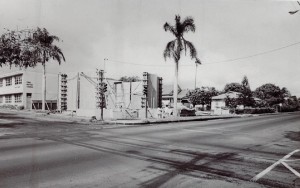 Bradford’s immediate acceptance by the people, and his success in bringing the Hawaiian opportunity to the attention of the regional and national leadership of American Baptists, led quickly to a great thrust of expansion. Within three years (1956-1958), churches were established in Kailua, Pearl Harbor, and Ewa Beach. Except for Pearl Harbor, where there had long been a branch Sunday School, this expansion followed no plan or strategy except to enter doors “as they were opened by the Holy Spirit.” With denominational support, all three branch churches soon became independent congregations, and, in a short time, their statistics equaled or surpassed those of First Baptist of Honolulu. Unexpectedly, 1958 marked the return to California of the Bradford family, due to health problems. However, this disappointment could not quench the optimism felt by the people of First Baptist as evidenced by the completion of the present educational facility. Also, planning continued for a new sanctuary, as it was feared that the old one might fall down “if the termites stopped holding hands.”
Bradford’s immediate acceptance by the people, and his success in bringing the Hawaiian opportunity to the attention of the regional and national leadership of American Baptists, led quickly to a great thrust of expansion. Within three years (1956-1958), churches were established in Kailua, Pearl Harbor, and Ewa Beach. Except for Pearl Harbor, where there had long been a branch Sunday School, this expansion followed no plan or strategy except to enter doors “as they were opened by the Holy Spirit.” With denominational support, all three branch churches soon became independent congregations, and, in a short time, their statistics equaled or surpassed those of First Baptist of Honolulu. Unexpectedly, 1958 marked the return to California of the Bradford family, due to health problems. However, this disappointment could not quench the optimism felt by the people of First Baptist as evidenced by the completion of the present educational facility. Also, planning continued for a new sanctuary, as it was feared that the old one might fall down “if the termites stopped holding hands.”
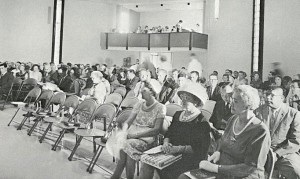 The present sanctuary was completed during the pastorate of the Rev. James Ledbetter. Windows were omitted from the handsome octagonal structure partly because it would be completely air conditioned, and partly because the traffic on Pensacola, still traveled both ways. The deafening noise of buses and trucks shifting hears and beginning the uphill climb had become a serious obstacle to worship. In addition to being the pastor “who built the sanctuary,” Ledbetter is remembered for his ability to bring together a broad spectrum of diverse peoples. One activity was a popular international ministry to students from the East-West Center at the University of Hawaii, Manoa.
The present sanctuary was completed during the pastorate of the Rev. James Ledbetter. Windows were omitted from the handsome octagonal structure partly because it would be completely air conditioned, and partly because the traffic on Pensacola, still traveled both ways. The deafening noise of buses and trucks shifting hears and beginning the uphill climb had become a serious obstacle to worship. In addition to being the pastor “who built the sanctuary,” Ledbetter is remembered for his ability to bring together a broad spectrum of diverse peoples. One activity was a popular international ministry to students from the East-West Center at the University of Hawaii, Manoa.
Jack Knighton served as pastor from 1965 to 1969, during which period the church opened the Day Care Center which continued to thrive, providing a needed service and evangelistic witness to children and parents in the neighborhood. Groundwork also was laid which later would result in welcoming the Trinity Missionary Baptist Church of Aiea into organizational fellowship with the other four churches of the Hawaii Association of American Baptists.
Truly, the fifteen years from 1955 to 1969 had been a time of advancement. Hundreds of persons came to know Christ personally through the direct and extended witness of the members of First Baptist. Hundreds more found a warm “home away from home.” Unfortunately, most of these people were military or civilians on short-term assignments who were rotated somewhere else; beneficiaries of a “ministry with a revolving door.” As pastors came and went, and as money became tighter and tighter, the feeling grew that this period of expansion had included some over-expansion.
“…Strengthen Your Stakes” Consolidation from 1970-1980
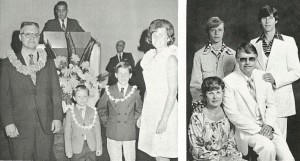 As the First Baptist Church of Honolulu celebrates its 50th anniversary, Dr. William Tipton celebrates his tenth as pastor. “Pastor Bill” arrived in Honolulu when the church – and, indeed, the entire Association – was in need of consolidation, stability, solid administration, and re-evaluation of goals. These were challenges which fit Bill Tipton’s interest and training like hand in glove. Within the entire American Baptist family, there had come, during this decade, a more realistic understanding of the problems as well as the opportunities of ministry in Hawaii. One thing that became clear was the fact that the transient nature of congregations would make it difficult for the newer churches to achieve financial independence, nor could the Board of National Ministries be expected to continue to assist indefinitely. Problems of finance and leadership become so pressing by 1977 that plans for regrouping became imperative.
As the First Baptist Church of Honolulu celebrates its 50th anniversary, Dr. William Tipton celebrates his tenth as pastor. “Pastor Bill” arrived in Honolulu when the church – and, indeed, the entire Association – was in need of consolidation, stability, solid administration, and re-evaluation of goals. These were challenges which fit Bill Tipton’s interest and training like hand in glove. Within the entire American Baptist family, there had come, during this decade, a more realistic understanding of the problems as well as the opportunities of ministry in Hawaii. One thing that became clear was the fact that the transient nature of congregations would make it difficult for the newer churches to achieve financial independence, nor could the Board of National Ministries be expected to continue to assist indefinitely. Problems of finance and leadership become so pressing by 1977 that plans for regrouping became imperative.
As a result, the Pearl Harbor congregation merged with its parent First Baptist Church in January, 1978, and its property was made available to the Trinity Missionary Baptist Church. First Baptist, Windward, weathered a split, and came to the end of the decade with new leadership and a careful optimism. In Ewa Beach, the work virtually died out in the late Seventies, but reorganized for a 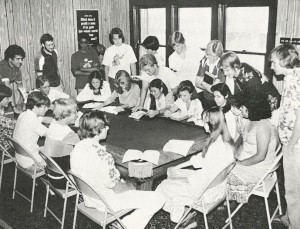 new start, with closer ties to the Regions’ office and National Headquarters. Pastor Tipton had been instrumental in this time-consuming process of consolidating and maintaining our American Baptist witness on Oahu. At the same time, First Baptist had given serious consideration to its own role and mission. Perhaps the four most significant trends during the decade had been: (1) the growth of a well-trained team of Lay Ministers of Evangelism, (2) the development of a specialized ministry to single persons, called Positive Christian Singles, (3) the increasing understanding by the members that responsible stewardship by the Lord’s people is the most efficient and effective way to support the Lord’s work, and (4) a marked growth of participation in the life of the church by persons of a variety of ethnic backgrounds.
new start, with closer ties to the Regions’ office and National Headquarters. Pastor Tipton had been instrumental in this time-consuming process of consolidating and maintaining our American Baptist witness on Oahu. At the same time, First Baptist had given serious consideration to its own role and mission. Perhaps the four most significant trends during the decade had been: (1) the growth of a well-trained team of Lay Ministers of Evangelism, (2) the development of a specialized ministry to single persons, called Positive Christian Singles, (3) the increasing understanding by the members that responsible stewardship by the Lord’s people is the most efficient and effective way to support the Lord’s work, and (4) a marked growth of participation in the life of the church by persons of a variety of ethnic backgrounds.
As it celebrates its Golden Anniversary, First Baptist Church can look over times of storm and calm. The main thing is that the church on this corner is alive and well, and that it fully acknowledges that the Lord is the source of its strength. Thus, it is better prepared than ever to reach out in faith, into the next decade, convinced, as was Adoniram Judson, that “the future is as bright as the promises of God.”


